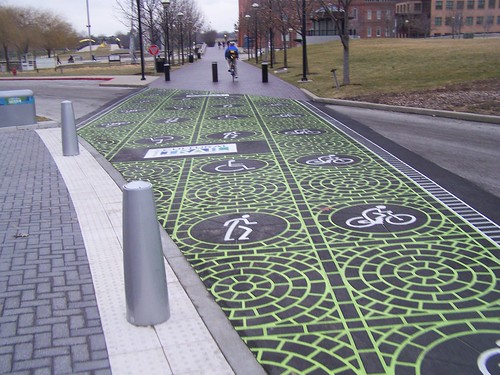A five foot sidewalk in a tunnel next to the light rail is a bad idea

Street crossing, Indianapolis Cultural Trail
Washcycle ("Purple Line likely to have 5-ft sidewalk through "tunnel", says MTA transportation planner") and the Examiner ("Small sidewalk possible for Purple Line tunnel under Wisconsin Ave ") report on a statement from a Maryland Transit Administration planner that perhaps a 5 foot wide sidewalk could be built in the tunnel at the proposed Bethesda light rail station.
I wrote about this general issue in February, in "Purple line and the bicycle trail conflict," and believe that a surface based alignment is an acceptable tradeoff, given far more people will be using the light rail system than they will be biking, and that the point is to promote the most good and most value for sustainable transportation overall, but also that a super high quality surface alignment that is highly visible is an important element of promoting biking as transportation (not just as recreation) as well.
But this 5 foot sidewalk proposal is a bad idea for another reason.
Federal Highway Administration guidance for both sidewalks and shared use paths wouldn't find this to be an acceptable width. If it's to be "better than nothing," maybe it's just better not to do something so inadequate and instead focus on doing something a lot better. (Like how in DC, I argue that just because a design is better than cinder block doesn't mean we should be satisfied.)
1. FHWA recommendations for sidewalks in highly pedestrianized areas would be 8-12 feet wide. I wrote about this here, "The tension in urban sidewalk design between privatized space, public space, and suburbanizing spaces."
SIDEWALK WIDTH (from page 339 of the PEDSAFE: Pedestrian Safety Guide and Countermeasure Selection System)
The width of a sidewalk depends primarily on the number of pedestrians who are expected to use the sidewalk at a given time — high-use sidewalks should be wider than low-use sidewalks. "Street furniture" and sidewalk cafes require extra width, too. A sidewalk width of 1.5 m (5 ft) is needed for two adult pedestrians to comfortably walk side-by-side, and all sidewalks should be constructed to be at least this width. The minimum sidewalk widths for cities large and small are:
Local or collector streets ---- 1.5 m (5 ft)
Arterial or major streets ---- 1.8 to 2.4 m (6 to 8 ft)
CBD areas ---- 2.4 to 3.7 m (8 to 12 ft)*
Along parks, schools, and other major pedestrian generators ---- 2.4 to 3.0 m (8 to 10 ft)
*2.4-m (8-ft) minimum in commercial areas with a planter strip, 3.7-m (12-ft) minimum in commercial areas with no planter strip.
When I wrote the Western Baltimore County pedestrian and bicycle access plan, I tried to put in recommendations for sidewalk width based on distance from transit stations. Within 1/2 mile it should be 10-12 feet. But all my design-specific recommendations were excised from the plan because of potential conflicts with the County DPW design manual. Although the plan still includes recommendations that a shared use path (multi-use trail) be constructed in association with the Red Line light rail proposed for Baltimore City and Baltimore County.
2. Speaking of FHWA, the Shared Use Path Level of Service Calculator should be the standard for determining how wide a shared use path should be generally, not just in association with light rail, such as the Purple Line alignment. There is no way that 5 feet is recommended for high use situations. AASHTO guidance, which I don't recommend, is a minimum of 8 feet. The recommended minimum width in the Shared Path LOS calculator is 11 feet.
Note that a 5 foot wide "sidewalk," shared with thousands of users in a constrained space, with users of a wide range of skill and experience--from toddlers to seniors, to "Lycra warriors" on bicyclists to duffers, is what I call "designing conflict in," making it likely that problems will occur.
The whole point of design, engineering, and planning is to "design conflict out," to reduce, not increase, problems and likelihood of accidents.
In any case, no state or local government agency should be allowed to construct biking and walking infrastructure that significantly deviates from standards and accepted practice and guidance.
For example, it's bad enough that local and state governments and public-private partnerships install substandard bicycle racks, that local planning and zoning guidance does not forbid such installation.
The guidance on bicycle parking from the Association for Bicycle and Pedestrian Professionals recommends that bicycle racks support bicycles at two points on the frame. The DC DOT guidance on bicycle parking also specifically does not recommend so-called "wave" racks.
Yet DC Government agencies (and federal agencies) install such racks as a matter of course.
So many sidewalk and trail installations are already substandard, we shouldn't further substandard infrastructure by having a 5 foot sidewalk in the Bethesda Purple Line light rail station.
Instead of building new substandard infrastructure, we should be correcting the already deficient substandard infrastructure, and building new high quality infrastructure going forward.
Labels: bicycling, sidewalks, transit infrastructure, transportation planning, urban design/placemaking




0 Comments:
Post a Comment
<< Home